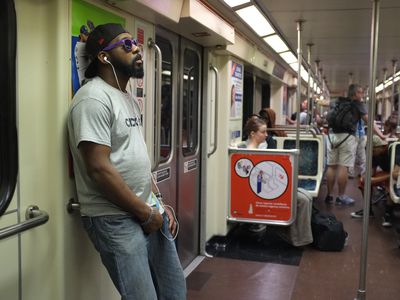
Ridership is down nearly 20 percent since 2013
Metro’s release last week of its July’s ridership statistics reveals the latest in a concerning trend: Fewer people are riding public transit in Los Angeles.
Overall ridership is down about 19 percent since July of 2013, the year that ridership most recently peaked, the latest figures show. Metro estimates 32.3 million boardings in July of 2017, down from 39.8 just four years ago. That’s across the entire system of bus, subway, and light rail lines. Bus ridership alone is down by 20 percent in the same period. That’s especially problematic, because buses carry more than twice as many passengers daily as Metro’s trains.
Even as Metro spends billions building out its rail system, the agency’s much larger network of 170 bus routes continues losing riders.
Metro officials are well aware of the problem. In May, the agency’s governing board launched a three-year plan to evaluate and restructure its bus network, in order “to develop a plan to retain current riders, reclaim past riders and recruit new riders.” Metro will conduct a rigorous study of its bus system’s merits and drawbacks, then roll changes by December of 2019, following public hearings and board approval.
A survey conducted by Metro of former riders who stopped using Metro found that many did so because their travel patterns changed (19 percent), that it was too hard to get to and from transit (12 percent), that the buses were too slow (18 percent), and that service was generally unreliable (11 percent).
But the fact remains that the only way to promise fast and convenient bus transportation in Los Angeles is to make sure those buses don’t get stuck in traffic. This means prioritizing buses over cars, which some public officials have hesitated to do. Try to replace a lane of traffic or on-street parking for a bus-only lane, and you’ll be met with public outcry, scorn, and possibly even lawsuits.
Below is a breakdown of four factors that contribute to lower ridership.
Traffic is worse
Because the vast majority of Metro’s buses do not have their own dedicated travel lanes, most of Metro’s buses get stuck in traffic. This is obvious, but it’s critical not to downplay how having to inch through LA’s noxious traffic challenges the level of service Metro can provide its riders. As traffic in LA worsens, and surface streets go from “congested” to “slammed at all hours,” buses simply move more slowly.
According to a recent Streetsblog analysis, the average speed of Metro buses has slipped by 13 percent over the previous decade. On average, Metro buses are now 2 mph slower than in 2005, most likely because Los Angeles’ grid has grown more congested over the same time.
Service cuts
Starting in about 2010, Metro began cutting its bus service, according to Streetsblog. Streetsblog quantitated “bus miles,” the total number of miles covered by Metro’s bus fleet, to analyze service. It found that, since 2005, the total number of vehicle revenue miles traveled by Metro buses has dropped by nearly 20 percent. This means that Metro’s buses cover about 20 percent less ground than they covered a decade ago.
A critique issued against Metro by some—notably the Bus Riders Union—is that the agency is paying too much attention to its rail riders at the expense of its bus riders. If Metro invested as heavily in its buses as its trains, the union argues, bus ridership would not be dropping like it is.
The Bus Riders Union successfully sued Metro for violating the Civil Rights Act in 1994, following a decade of service cuts that reduced ridership from nearly 500 million annual riders in 1985—before LA had even a single rail line—to just 362 million in 1995. (Metro’s 2016 annual ridership was just shy of 416 million annual riders, of which 304 million were aboard buses.)
After the union successfully argued that bus service cuts amounted to civil rights violations for the predominantly poor and non-white riders, a judge placed Metro under a judicial consent decree with requirements to provide a high level of bus service. Ridership rebounded into the 2000s, until the consent decree expired in 2006.
Fuel is cheaper
Los Angeles is hardly the only city where regional transit systems are losing riders. Nationwide, transit ridership in most major cities has been declining, matched by a parallel national increase in driving. Los Angeles’ most recent ridership peak was in 2013, when gas regularly cost more than $ 4 per gallon.
As fuel gets cheaper, more people opt to drive. This is also part of the reason why traffic is noticeably worse in 2017 than it was five years ago.
Housing costs
Compared to 20 years ago, many of the most transit accessible neighborhoods in Los Angeles are significantly more expensive, and home to more affluent demographics than they once were. As the transit-riding demographics get priced out of relatively central and transit-friendly neighborhoods, and move to the cheaper but more far-flung and car dependent suburbs, ridership suffers.
While there has been little dedicated research on this specific phenomena, consider the ridership of the No. 2 bus route, which runs along Sunset Boulevard from Downtown LA, through Echo Park, Silver Lake and Hollywood, to Pacific Palisades.
In July of 2009, the Sunset Boulevard bus carried just over 22,000 passengers daily. Last month, the same route carried about 14,300 passengers daily. While other factors might explain the dip in ridership, the fact remains that a bus traveling along a gentrification corridor lost 35 percent of its riders during a period when Metro’s total system lost 15 percent of its riders, Metro data shows.
